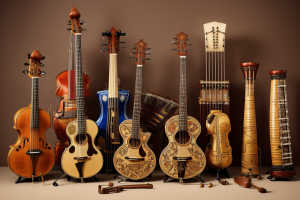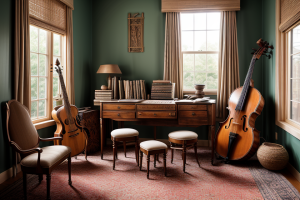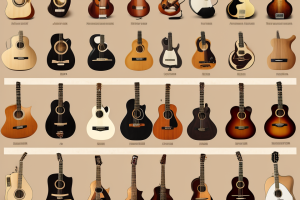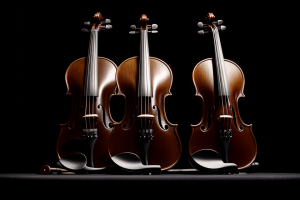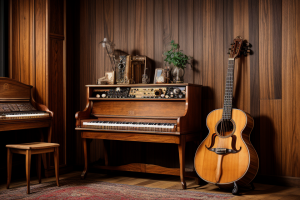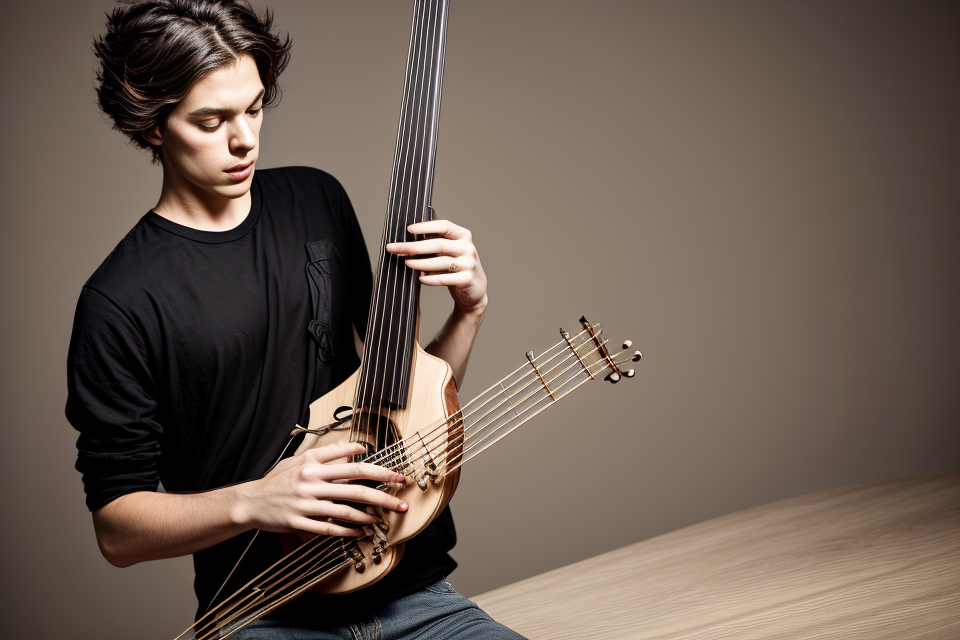
Music is an art form that has been around for centuries, and over time, it has evolved into a complex and diverse medium. One of the most fascinating aspects of music is the use of instruments. Instrumentation is the process of selecting and arranging musical instruments to create a particular sound or effect. The purpose of instrumentation in music is to enhance the overall sound of a piece and to create a unique and memorable experience for the listener. In this article, we will explore the role of instrumentation in music and the importance of custom instrument creation in achieving the desired sound. We will delve into the history of instrumentation, the different types of instruments used in music, and the benefits of custom instrument creation. So, let’s get started and discover the magic of instrumentation in music!
What is Instrumentation in Music?
Definition and Purpose
Instrumentation in music refers to the combination of different instruments and voices used to create a particular musical work. It encompasses the choice of instruments, their arrangement, and the way they are used to produce sound. The purpose of instrumentation is to create a unique and engaging musical landscape that supports the overall artistic vision of the composer or performer.
- Definition of instrumentation:
Instrumentation can be defined as the specific combination of instruments used in a particular piece of music. It includes the choice of instruments, their range, timbre, and dynamics, as well as the way they are used to create a cohesive musical texture. - The role of instrumentation in music:
Instrumentation plays a crucial role in shaping the overall sound and character of a musical work. It can evoke different emotions, create a sense of space and depth, and highlight certain melodic or harmonic elements. Instrumentation can also influence the audience’s perception of the music, as it can suggest cultural or historical contexts, or convey a particular mood or atmosphere. - Creating a musical landscape:
The choice of instruments and their arrangement can greatly affect the musical landscape of a piece. Instrumentation can create a sense of balance and harmony, or generate contrast and tension. It can also highlight different musical elements, such as melody, harmony, or rhythm, and help the listener to focus on specific aspects of the music. The way instruments are used together can also create a sense of unity and coherence, or convey a sense of fragmentation and dissonance. Overall, instrumentation is a powerful tool for composers and performers to shape the musical experience and convey their artistic vision.
Types of Instrumentation
In music, instrumentation refers to the selection and arrangement of instruments used to create a specific sound or style. It is an essential aspect of music production, as it determines the overall character and tone of a piece.
There are several types of instrumentation in music, each with its unique sound and role in creating a musical composition. Here are some of the most common types of instrumentation:
Woodwinds
Woodwinds are a family of instruments that produce sound by blowing air through a reed or mouthpiece. This family includes instruments such as the flute, clarinet, saxophone, and oboe. Woodwinds are known for their melodic and expressive qualities, and they are often used to create solos and melodic lines in a piece of music.
Brass
Brass instruments produce sound by vibrating lips or a buzzing tongue against a metal mouthpiece. This family includes instruments such as the trumpet, trombone, and French horn. Brass instruments are known for their bright and powerful sound, and they are often used to create strong, attention-grabbing passages in a piece of music.
Percussion
Percussion instruments produce sound through striking, shaking, or scraping. This family includes instruments such as drums, cymbals, and maracas. Percussion instruments are used to provide rhythm and texture to a piece of music, and they can also be used to create solos and melodic lines.
Strings
Strings are a family of instruments that produce sound by vibrating strings with a bow or plucking them with fingers. This family includes instruments such as the violin, viola, cello, and double bass. Strings are known for their rich and complex sound, and they are often used to create harmonies and textures in a piece of music.
Keyboard
Keyboard instruments produce sound by pressing keys that trigger hammers or other mechanisms to strike strings or produce electronic sounds. This family includes instruments such as the piano, organ, and synthesizer. Keyboard instruments are versatile and can be used to create a wide range of sounds and textures in a piece of music.
In conclusion, the type of instrumentation used in a piece of music can greatly affect its overall character and tone. Each type of instrument has its unique sound and role in creating a musical composition, and understanding these different types of instrumentation is essential for any musician or music producer.
Custom Instrument Creation
Why Custom Instruments Matter
Custom instruments are essential in music as they provide musicians with the ability to create unique sounds that can be incorporated into their music. This can add a distinctive flavor to their music, making it stand out from the rest. Custom instruments also enable musicians to expand the range of instruments available to them, which can open up new possibilities for creative expression. Additionally, custom instruments can help musicians explore new sonic territories, enabling them to push the boundaries of what is possible in music.
One of the primary reasons why custom instruments matter is that they allow musicians to create unique sounds that can be incorporated into their music. These sounds can be created by modifying existing instruments or by building new ones from scratch. For example, a musician may decide to create a custom guitar by adding extra strings or by using unconventional materials for the body of the instrument. This can result in a sound that is entirely new and different from any other guitar.
Custom instruments also enable musicians to expand the range of instruments available to them. This is particularly important in genres of music that require a wide range of sounds, such as classical music or electronic music. By creating custom instruments, musicians can add new instruments to their arsenal, enabling them to produce a wider range of sounds. For example, a musician may create a custom electronic instrument that can produce a sound that is not possible with conventional instruments.
Finally, custom instruments can help musicians explore new sonic territories. This is particularly important for musicians who are looking to push the boundaries of what is possible in music. By creating custom instruments, musicians can experiment with new sounds and techniques, enabling them to discover new musical possibilities. For example, a musician may create a custom instrument that can produce a sound that has never been heard before. This can lead to the development of new musical styles and genres, which can have a significant impact on the music industry.
In conclusion, custom instruments are essential in music as they provide musicians with the ability to create unique sounds, expand the range of instruments available to them, and explore new sonic territories. This can have a significant impact on the music industry, leading to the development of new musical styles and genres.
Benefits of Custom Instrument Creation
Custom instrument creation has numerous benefits that have transformed the music industry. One of the most significant advantages of custom instrument creation is the ability to improve the quality of sound. By crafting instruments with specific materials and design features, luthiers and instrument makers can create unique tones and timbres that are not possible with traditional instruments. For example, a custom-made electric guitar may have a unique pickup configuration or wood type that produces a distinct sound that sets it apart from other guitars on the market.
Another benefit of custom instrument creation is the ability to create instruments tailored to specific musicians. Every musician has unique preferences when it comes to their instrument’s size, shape, and feel. Custom instruments can be designed to meet the specific needs of individual musicians, providing them with a more comfortable and enjoyable playing experience. For instance, a violin maker may create a custom violin with a smaller body size for a younger musician or a custom cello with a longer neck for a taller musician.
Customizing the playing experience is another significant advantage of custom instrument creation. Musicians can work with instrument makers to design instruments that are tailored to their specific playing style and technique. This can include features such as custom fretboard inlays, unique fingerboard radii, and specialized bridges that enhance the instrument’s playability and responsiveness. As a result, musicians can achieve a more personalized and expressive playing experience that is not possible with off-the-shelf instruments.
Overall, custom instrument creation offers numerous benefits that can enhance the quality of sound, create instruments tailored to specific musicians, and customize the playing experience. With the advancement of technology and the growing demand for unique and personalized instruments, custom instrument creation is becoming an increasingly popular trend in the music industry.
The Process of Custom Instrument Creation
Design and Construction
The process of custom instrument creation begins with the design and construction phase. This involves the crafting of an instrument from scratch, tailored to the specific needs and preferences of the musician. The designer must consider various factors such as the desired sound, the size and shape of the instrument, and the materials to be used. This phase requires a deep understanding of acoustics, music theory, and the physics of sound production.
Choosing Materials
Once the design is complete, the next step is to choose the materials for the instrument. The choice of materials can greatly affect the sound of the instrument, and different materials produce different tonal qualities. For example, wood is a common material used in instrument construction due to its ability to produce a warm and resonant sound. However, other materials such as metal, plastic, and carbon fiber can also be used to create unique sounds.
In addition to the material itself, the quality and density of the material are also important factors to consider. The grain pattern and texture of the wood, for example, can affect the instrument’s resonance and sustain. The craftsman must carefully select the materials and cut them to the right dimensions to ensure the best possible sound quality.
Tuning and Adjustments
After the instrument has been constructed, it must be tuned and adjusted to ensure optimal performance. This involves adjusting the strings, bridges, and other components to achieve the desired tuning and intonation. The craftsman must use specialized tools and techniques to make these adjustments, and must have a keen ear to accurately tune the instrument.
Tuning and adjustments are crucial to the success of the custom instrument. A poorly tuned instrument can sound out of tune and unpleasant to listen to, and can make it difficult for the musician to play accurately. Therefore, the craftsman must take great care in this phase to ensure that the instrument is ready for use.
In conclusion, the process of custom instrument creation is a complex and multifaceted process that requires a deep understanding of music theory, acoustics, and instrument design. The craftsman must carefully consider the materials, design, and tuning to create an instrument that is tailored to the needs of the musician and capable of producing a high-quality sound.
The Impact of Custom Instruments on Music
How Custom Instruments Have Shaped Music
Custom instruments have played a significant role in shaping music throughout history. These unique creations have not only expanded the range of sounds available to musicians but have also inspired new musical styles and genres.
The history of custom instruments
The history of custom instruments dates back to ancient civilizations, where musicians would create their own instruments using locally available materials. In medieval Europe, luthiers would craft custom stringed instruments such as the lute and the viol, which were popular in court and church music.
During the Renaissance, the invention of the violin marked a significant milestone in the history of custom instruments. Its unique design and versatility allowed it to become a staple in classical music, with composers such as Bach and Vivaldi writing specifically for the instrument.
In the 20th century, custom instruments continued to evolve with the introduction of electronic instruments such as the synthesizer and the theremin. These innovative creations expanded the possibilities of sound production and opened up new avenues for musical experimentation.
Iconic custom instruments in music
Throughout history, there have been several iconic custom instruments that have left an indelible mark on music. One such example is the sitar, a stringed instrument originating from India, which was adopted by Western musicians in the 1960s, most notably by the Beatles in their song “Norwegian Wood.”
Another example is the chapman stick, an electric instrument invented by Emmett Chapman in the 1960s, which combines elements of the guitar, bass, and keyboard. It has been used by renowned musicians such as Steve Howe of Yes and Tony Levin of King Crimson, among others.
Custom instruments have also played a significant role in popular music, with musicians such as Frank Zappa and Jimi Hendrix creating their own unique instruments to achieve their distinctive sounds. These innovative creations have inspired generations of musicians to push the boundaries of what is possible with music.
In conclusion, custom instruments have played a vital role in shaping music throughout history. From ancient civilizations to the present day, these unique creations have expanded the range of sounds available to musicians and inspired new musical styles and genres.
The Future of Custom Instruments in Music
Custom instruments have come a long way since their inception, and their future looks brighter than ever. Here are some emerging trends in custom instrument creation that are shaping the future of music:
Incorporation of Technology
The integration of technology has revolutionized the world of custom instruments. Advancements in materials science, computer-aided design, and 3D printing have enabled instrument makers to create instruments with unprecedented precision and customization. This has opened up new possibilities for musicians to explore new sounds and techniques, and for instrument makers to push the boundaries of what is possible.
Focus on Sustainability
In recent years, there has been a growing awareness of the environmental impact of music production. Custom instrument makers are responding to this by creating instruments made from sustainable materials, such as bamboo, carbon fiber, and recycled materials. This not only reduces the environmental footprint of music production but also opens up new aesthetic possibilities for instrument design.
Virtual Instruments
Another emerging trend in custom instrument creation is the development of virtual instruments. These are software-based instruments that can be played on a computer or mobile device. They offer a wide range of sounds and capabilities that are not possible with traditional instruments, and they can be easily customized to suit the needs of individual musicians.
Collaborative Design
Finally, there is a growing trend towards collaborative design in custom instrument creation. Musicians and instrument makers are working together to create instruments that are tailored to the needs of specific musicians or musical genres. This collaborative approach has led to some truly innovative and groundbreaking instruments that are pushing the boundaries of what is possible in music.
Overall, the future of custom instruments in music looks bright, with new technologies, materials, and design approaches enabling instrument makers to create instruments that are more customizable, sustainable, and innovative than ever before. As the world of music continues to evolve, custom instruments will play an increasingly important role in shaping the sounds and techniques of the future.
FAQs
1. What is instrumentation in music?
Instrumentation in music refers to the selection and arrangement of instruments used in a composition or performance. It involves choosing specific instruments to create a desired sound or effect and determining how they will be played and combined to achieve the desired musical outcome.
2. Why is instrumentation important in music?
Instrumentation is important in music because it allows composers and musicians to create a wide range of sounds and effects that can enhance the emotional impact and overall quality of a piece. By carefully selecting and arranging instruments, musicians can create unique and memorable sounds that can help to convey the intended mood or message of a piece.
3. What is custom instrument creation?
Custom instrument creation refers to the process of designing and building instruments that are tailored to a specific composer or performer’s needs or preferences. This can involve modifying existing instruments or creating entirely new ones using a variety of materials and techniques. Custom instrument creation allows musicians to achieve a unique sound or playing experience that may not be possible with traditional instruments.
4. Why is custom instrument creation important in music?
Custom instrument creation is important in music because it allows musicians to push the boundaries of what is possible with traditional instruments and explore new sounds and techniques. By creating custom instruments, musicians can expand their creative possibilities and find new ways to express themselves through music. Additionally, custom instruments can be tailored to the specific needs of a performer, which can help to improve their playing technique and overall musicality.
5. How does instrumentation affect the audience’s perception of a piece?
Instrumentation can have a significant impact on the audience’s perception of a piece of music. Different instruments can evoke different emotions and associations, and the way they are arranged and played can create a wide range of musical effects. For example, a piece composed for a full orchestra may create a sense of grandeur and majesty, while a piece composed for a small ensemble of instruments may create a more intimate and introspective mood. By carefully selecting and arranging instruments, composers and musicians can shape the audience’s experience of a piece and create a powerful emotional impact.
